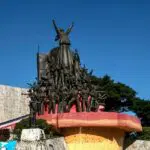People Power Revolution Day is an important holiday observed every year in the Philippines on February 25. The holiday commemorates the public demonstrations that took place between February 22 and 25, 1986. The aftermath of this revolution led to the deposition of a tyrannical government and the beginning of a new political dispensation in the Philippines. The movement was internationally celebrated for being peaceful despite government opposition. The revolution also inspired other countries that adopted the same non-violent approach.
History of People Power Revolution
Between February 22 and 25, 1986, a series of peaceful demonstrations took place in Metro Manila on a now-famous avenue called Epifanio de los Santos Avenue, popularly known as EDSA. These non-violent demonstrations happened in protest of the oppressive and tyrannical government of President Ferdinand Marcos. During his 20-year rule, he declared martial law, and poverty levels in the Philippines skyrocketed. His rule was fraught with human rights violations, electoral malpractice, and violence against members of the opposition.
The main event that sparked the demonstrations was the Philippine military’s assassination of Senator Benigno Aquino or Ninoy Aquino, as he was more commonly known. This act shocked and spurred the people into action. For three days, people from all walks of life gathered at EDSA. The mood was surprisingly festive, with concert-like activities. Priests and nuns led the people in prayer, and performers kept the people’s spirits up. During these events, the military began defecting and disobeying government orders. A military squadron sent to attack a gathering of civilians at Camp Crane disobeyed orders and landed the helicopter on the ground amidst cheers from the crowd.
Finally, on the morning of February 25, 1986, at a place called Club Filipino, the widow of the late Ninoy Aquino was sworn in as President of the Philippines. In a symbolic move, the “Bible” on which the oath of office was sworn was held by her mother-in-law, the mother of Ninoy Aquino. At midnight, Marcos and his family departed the Philippines and never returned.
People Power Revolution timeline
The Spanish colonial period ends with the Philippine Revolution.
War breaks out as America refuses to recognize the first Philippine Republic.
Marcos is elected President of the Philippines.
Martial law is declared in the Philippines.
The People Power Revolution takes place over the course of three days.
The People Power Revolution is declared a non-working holiday in the Philippines.
People Power Revolution FAQs
Why is the word ‘Filipino’ spelled with an ‘f’?
Filipino is spelled with an ‘f’ because the Spanish name for the Philippines is ‘las Islas Filipinas.’
What languages do Filipinos speak?
The Philippines has about 175 languages but the official languages are Filipino and English.
On what continent is the Philippines located?
The Philippines is located in Southeast Asia.
When was the People’s Power Revolution in the Philippines?
The People Power Revolution (also known as the E.D.S.A. Revolution and the Philippine Revolution of 1986) was a series of popular demonstrations in the Philippines that began in 1983 and culminated in 1986. The methods used amounted to a sustained campaign of civil resistance against regime violence and electoral fraud.
What is the largest ethnic group in the Philippines?
The Tagalogs are the largest ethnic group in the Philippines.
Who controlled the Philippines from 1521 to 1821?
The Philippines was discovered in 1521 by Portuguese explorer Ferdinand Magellan and colonized by Spain from 1565 to 1898. Following the Spanish–American War, it became a territory of the United States.
How to Observe People Power Revolution
Celebrate with the Philippines
Don’t let them celebrate alone. Wish all Filipinos you know a happy holiday or send a goodwill message online.
Read about the movement
If you want to know more about People Power Anniversary, read articles, newspaper reports, and books on it. It is the best way to celebrate People Power Anniversary.
Create awareness
It’s time to share what you’ve learned with others. Have a conversation in person or use the hashtag #peoplepowerrevolution in an online post.
5 Important Facts About The Philippines
Keep the flag up
When the Filipino flag is upside down, it means that the country is at war.
A lot of Filipinos speak English
The Philippines is the fifth-largest English-speaking nation in the world.
They rarely say “no”
Instead of saying “no” to an invitation or request, Filipinos prefer to say “maybe,” ‘alright,” or “let’s see” to avoid offending.
Manila City Hall is weirdly shaped
When viewed from above, Manila City Hall looks like a coffin with a cross.
President Marcos was buried after 30 years
Though President Marcos died in 1986, his body remained on ice until he was buried in 2016.
Why People Power Revolution is Important
The revolution was peaceful
Even though the word revolution is usually associated with violence and bloodshed, the people of the Philippines took a different route. Without weapons and military might, they fought for the change they desired.
The revolution led to freedom
Thankfully, this revolution did not culminate in a bloody war as many others have. Rather, it led to the peaceful installation of a new president and ended decades of an oppressive and corrupt regime.
It teaches us about the power of the common man
We tend to forget that the people are an important element in any democracy, and they have the power to make or break governments. People Power Anniversary reminds us of this.
People Power Revolution dates
| Year | Date | Day |
|---|---|---|
| 2025 | February 25 | Tuesday |
| 2026 | February 25 | Wednesday |
| 2027 | February 25 | Thursday |
| 2028 | February 25 | Friday |
| 2029 | February 25 | Sunday |















